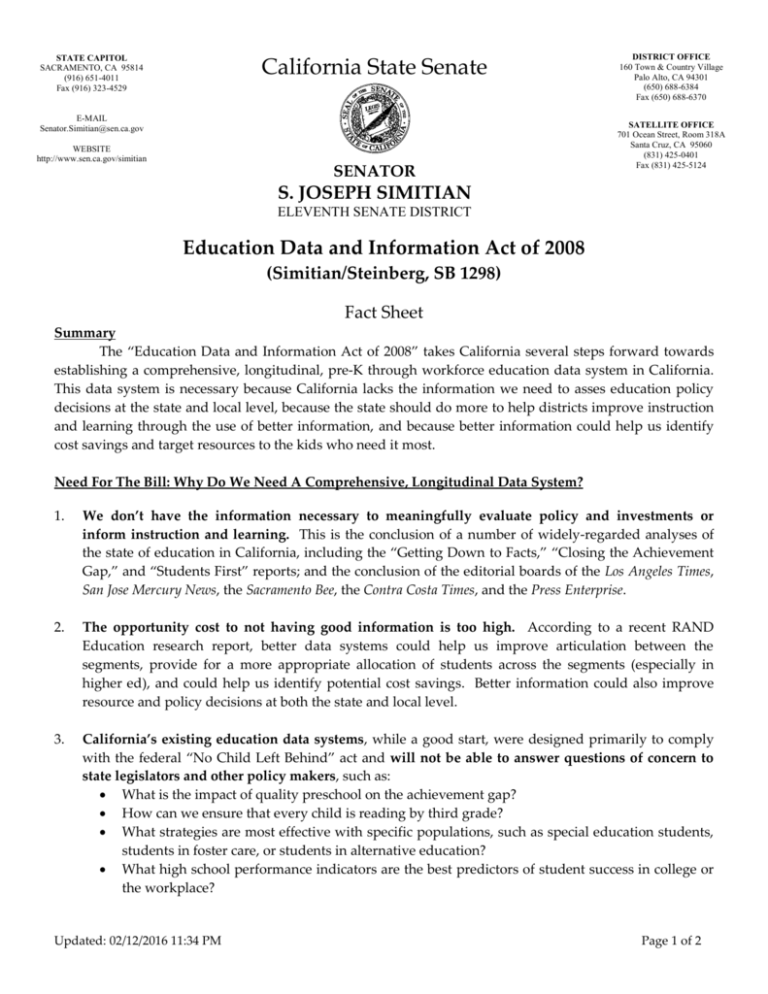SB 1298 "Fact Sheet" - State Senator Joe Simitian
advertisement

California State Senate STATE CAPITOL SACRAMENTO, CA 95814 (916) 651-4011 Fax (916) 323-4529 E-MAIL Senator.Simitian@sen.ca.gov WEBSITE http://www.sen.ca.gov/simitian SENATOR DISTRICT OFFICE 160 Town & Country Village Palo Alto, CA 94301 (650) 688-6384 Fax (650) 688-6370 SATELLITE OFFICE 701 Ocean Street, Room 318A Santa Cruz, CA 95060 (831) 425-0401 Fax (831) 425-5124 S. JOSEPH SIMITIAN ELEVENTH SENATE DISTRICT Education Data and Information Act of 2008 (Simitian/Steinberg, SB 1298) Fact Sheet Summary The “Education Data and Information Act of 2008” takes California several steps forward towards establishing a comprehensive, longitudinal, pre-K through workforce education data system in California. This data system is necessary because California lacks the information we need to asses education policy decisions at the state and local level, because the state should do more to help districts improve instruction and learning through the use of better information, and because better information could help us identify cost savings and target resources to the kids who need it most. Need For The Bill: Why Do We Need A Comprehensive, Longitudinal Data System? 1. We don’t have the information necessary to meaningfully evaluate policy and investments or inform instruction and learning. This is the conclusion of a number of widely-regarded analyses of the state of education in California, including the “Getting Down to Facts,” “Closing the Achievement Gap,” and “Students First” reports; and the conclusion of the editorial boards of the Los Angeles Times, San Jose Mercury News, the Sacramento Bee, the Contra Costa Times, and the Press Enterprise. 2. The opportunity cost to not having good information is too high. According to a recent RAND Education research report, better data systems could help us improve articulation between the segments, provide for a more appropriate allocation of students across the segments (especially in higher ed), and could help us identify potential cost savings. Better information could also improve resource and policy decisions at both the state and local level. 3. California’s existing education data systems, while a good start, were designed primarily to comply with the federal “No Child Left Behind” act and will not be able to answer questions of concern to state legislators and other policy makers, such as: What is the impact of quality preschool on the achievement gap? How can we ensure that every child is reading by third grade? What strategies are most effective with specific populations, such as special education students, students in foster care, or students in alternative education? What high school performance indicators are the best predictors of student success in college or the workplace? Updated: 02/12/2016 11:34 PM Page 1 of 2 4. Complicating matters, our existing education data systems are highly fragmented. We can’t communicate seamlessly across segments -- such as early education, K-12 and higher education -- or across time, so it is difficult to analyze the performance of our education system as a whole and over time. It is even difficult to communicate between K-12 districts. It can take weeks or months for records to arrive when a student transfers between districts. 5. No one in the existing governance structure is responsible, or has the authority, to provide a comprehensive, integrated education data system. California currently has over 150 different sources of data, across tens of state agencies, which would be useful for a comprehensive analysis of our education system. If you narrow the parameters to count only the key systems like CalPADS and the core systems from higher ed, there are eight state education data systems that need to be linked. Additionally, in order to analyze education outcomes or better serve specific populations, linkages to non-education data sets -- such as workforce data -- may be particularly useful. If you add just the key data sets from non-education sources to the mix, then there are approximately 20 data systems that will need to be pulled together if the vision of a comprehensive, longitudinal data system is to be realized. However, these existing information systems were developed to meet various, specific, and unique institutional needs. Their integration will require focused, intense, and independent institutional volition -- tied to accountability -- if it is to be successful. What This Bill Would Do Simply put, this bill would do three really important and relatively low-cost things. It would: 1. convene a high-level working group to decide the best the governance structure for the comprehensive education data system; 2. directs the State Chief Information Office (CIO), in consultation with educators and education policymakers, to prepare a strategy plan outlining a clear path for technical implementation; and 3. requires the various education segments to begin using a common student identifier, so that once a governance structure and technical architecture are in place we can begin linking records from prek through the university with relative ease and speed. Support Applied Survey Research Bay Area Council Business Roundtable for Education Foundation California ACORN CASBO California Community Colleges, Chancellor’s Office California Competes (JV:SV initiative) Children Now Education Trust West Fight Crime: Invest in Kids First 5 California John W. Gardner Center for Youth and Their Communities’ (Stanford) Los Angeles Chamber of Commerce PICO Preschool California Public Advocates Mayor Gavin Newsom REAL Coalition Schoolwise Press Silicon Valley Leadership Group South and West Area Business Association TechNet For More Information: Heather Barbour, (916) 651-4011 or heather.barbour@sen.ca.gov Updated: 02/12/2016 11:34 PM Page 2 of 2











